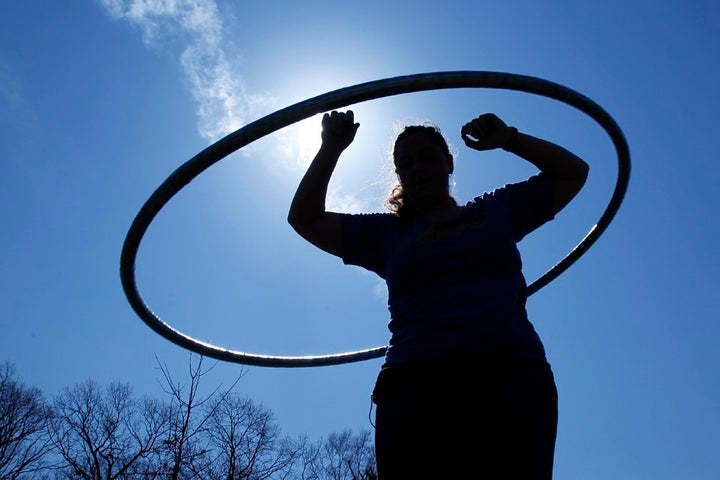
By Ed Yong
Imagine a calendar. Chances are you just thought about a rectangular grid, with time progressing from the top-left to the bottom-right. But around one percent of you may have pictured something different—a V, for example, or a hoop encircling your head.
These weird shapes are called “calendar forms.” They’re a type of synesthesia—the mental phenomenon where people involuntarily map one type of sensation onto another. Some associate letters or numbers with colors, others taste sounds or see smells, and people with calendar forms map time onto space. Sure, everyone does that to an extent—for example, we might picture numbers on a line going from left to right. But calendar forms are especially vivid and perceptually real—people actually see the units of time occupying the space around their bodies.
The English polymath Francis Galton first described calendar forms in 1880, and the phenomenon has been rarely studied since. But Vilayanur Ramachandran, a neuroscientist at the University of California, San Diego who has been studying synesthesia for a long time, has been slowly amassing and studying people with this odd perceptual quirk.
He met one such person, a 25-year-old woman named Emma, a year ago. Her calendar is a hula hoop, which stretches horizontally in front of her and touches her chest at one point—always December 31st, no matter the actual time of year. Emma uses her calendar to organize her life, attaching events to the various months and zooming around the hoop to access them.
The hoop is anchored to her body; it doesn’t move if she tilts or rotates her head. “Obviously, this is a construct in her head, not a real hula hoop stuck to her chest,” says Ramachandran. But if she turns her head to the right, the left side of the calendar became fuzzier, as it would be if it was an actual physical object. More bizarrely, the memories that she had appended to those months also became indistinct and harder to recall.
To Ramachandran, this beautifully illustrates a concept called “embodied cognition,” which says that the way we think isn’t just the product of our brains, but is also profoundly influenced and constrained by our bodies. In this case, Emma’s neck and eye muscles are effectively opening and shutting the gates to at least some of her memories. “It’s one of the most striking examples of embodied cognition that I know of,” Ramachandran says. “And it provides strong hints that [the calendar form] is a legitimate biological phenomenon.
Then again, much of this relies on Emma’s own testimony. So when Ramachandran met a second woman with a calendar form, a 20-year-old named Megan, he did some experiments. Her calendar is a mirror-image check mark, with January on the top-left corner, September at the bottom, and December on the top-right.
First, Ramachandran asked Megan to name the months of the year backwards from a random starting point. Most people find this task harder than they expect—they hesitate, or make mistakes. But Megan was much faster than average, even on more difficult variations like skipping every other month, or two months at a time. She was actually reading the months off her calendar: Ramachandran filmed her shifting her gaze to the right positions and sometimes moving her index finger too.
RELATED: The Case Against Reality
“These results show the calendar is not some vague figment of her imagination,” he writes. “It is vivid enough to enhance performance on a cognitive task that is difficult for non-synesthetes.” (When I tried the test he said, “You’re better than most regular people but still about half Megan’s speed.”)
Rosa Rugani from the University of Padova is intrigued by the case, but notes that Ramachandran asked Megan to draw out her calendar before the test. “It’s possible that the effort in drawing the calendar, which requires visualizing it, might have helped in the task,” she says.
That said, Ramachandran found that Megan’s calendar is also vulnerable to visual illusions. For example, if you stare at a contracting spiral for several seconds and then look at another object, it will seem to expand. That illusion won’t work if you just imagine an object on a white screen; you have to be looking at a real thing. And indeed, when Megan visualized her check-mark-shaped calendar on a screen, it did expand, behaving like a real object.
Here’s another illusion. When old-fashioned TV screens lost signal, they’d show snow—black dots on a white background. If you put a black rectangle over the screen, the dots within that shape seem to clump together and move more slowly. And if you move the black border, the dots within seem to get dragged along. And that’s exactly what Megan saw when she visualized her calendar on top of a display of electronic snow.
“This shows that the calendar isn’t the United Nations—an airy nothing,” says Ramachandran. “It’s behaving like a real physical object out there in the world, but of course it’s not.”
What’s actually happening in Emma and Megan’s brains? For now, no one knows. Ramachandran wants to focus on a small part of the brain called the angular gyrus. It is involved in arithmetical skills, directing our attention to particular parts of space, combining information from our various senses, and many other mental skills. It is also connected to the hippocampus, another brain region involved in navigation and spatial memory.
Perhaps it’s unusually strong connections between these regions that allow some people to vividly map numbers and time onto space. Ramachandran could test this idea by using magnetic fields to temporarily disrupt the angular gyrus; if he’s right, the calendars should disappear.
This story originally appeared on TheAtlantic.com.
More from The Atlantic: The Lessons of Henry Kissinger, How to Email
